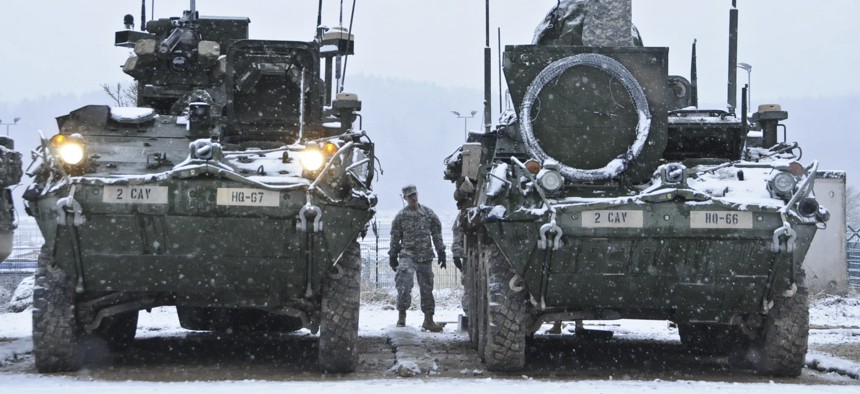
Soldiers at the exercise Allied Spirit I at Hohenfels Training Area located in Hohenfels, Germany, Jan. 20, 2015. U.S. Army photo
Unpredictability Is the Biggest Threat Facing America’s Army
Foes are increasing their reach in unexpected ways, while budget whiplash at home is needlessly draining the force of time and resources.
Unpredictable threats and unpredictable resources will be at the heart of many discussions when the Association of the U.S. Army’s 2016 Annual Meeting and Exposition begins on Monday. The biggest challenge facing America’s Army is how to be ready today to meet an ever-expanding array of missions while preparing for the future in a fast-moving and increasingly threatening international security environment, all the while coping with a highly uncertain budget outlook.
Our three-day annual meeting at Washington, D.C.’s convention center provides a platform for wide-ranging, candid discussions on the way forward for the world’s greatest land force. These are dangerous times, with unquestionable risk. The task facing the Army, certain to be a major part of our discussion, is how to achieve a balance that minimizes current risks while building for the future.
It’s no easy task. It requires balancing budget resources between current and future needs, and also balancing among the many capabilities required for the Army to accomplish its vital missions in support of our national security objectives at home and abroad. Determined cooperation of the Regular Army, Army National Guard, and Army Reserve must also be part of the Army’s future. Also required is for our nation’s political leaders to reach agreement to not only adequately fund defense programs but also to prevent unnecessary cliffhangers.
Make no mistake, there are national security risks of operating with tight and precarious budgets. Even the most forward-looking and innovative leaders—which today’s Army has—have no magical abilities to both fully maintain the robust counterterrorism capabilities needed for near-term operations and threats while also prudently discovering and securing the technologically advanced systems needed for the future. Instead, our Army and our nation face the stark choice of scrimping on readiness and capabilities today or short-changing our future. Neither is acceptable. We cannot gamble on America’s future.
The Army is, after all, still globally deployed today in support of combatant commands. The pace of commitments remains high while the Army gets smaller.
See also Disjointed: Pentagon Isn’t Coordinating Efforts to Fix Readiness
Read more The Army’s Coming Readiness Challenge is No Myth
And To Counter Russia’s Cyber Prowess, US Army Launches Rapid-Tech Office
This has led the Army to prioritize investments on only the most critical capability gaps. The technology advantage the U.S. has held over potential adversaries is eroding as peer and near-peer nations develop and field advancements on such things as active protection systems. Even nations with no standing army can pose a risk to Army formations by taking advantage of inexpensive and widely available technologies.
To help address these challenges, we’ve scheduled three days of discussion about what the Army needs for its doctrine, leadership development, and weapons. Formal professional forums will look at threats now and in the future, as well as new ways of partnering with other services, allies and industry.
One of our most important discussions involves senior leaders from the Army, Marine Corps, Navy, Air Force, and foreign partners focused on multi-domain operations that will demand increased levels of cooperation and coordination. Our professional forum is about not just the Army’s future, but the future of national security because no single service can assume they’ll command continuous superiority in any single domain. A joint effort, and a multinational effort, is necessary to defeat adversaries who have mastered the ability to complicate communications and maneuvers in a domain where we’ve been dominant. Synchronized, integrated operations across land, air, sea, space and cyberspace will be able through speed and surprise to win battles, consolidate gains and secure sustainable outcomes
It is highly unlikely we’ll ever have a predictable and peaceful world in the near future, but the Army needs an adequate and a predictable budget so smart decisions can be made about priorities. It also needs a national security strategy in which commitments matched resources and resolve.



